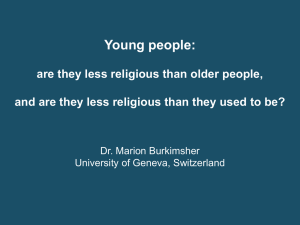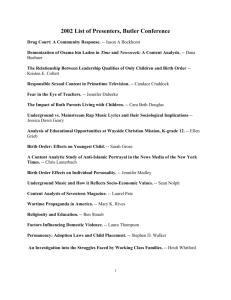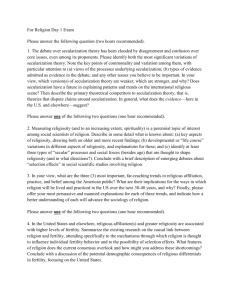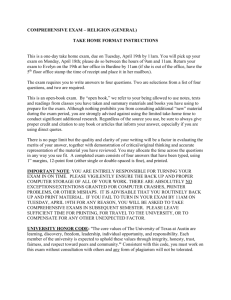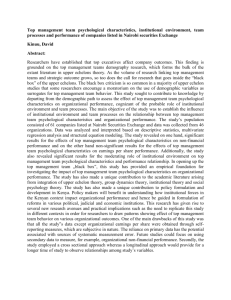The psychological benefits of income are contingent on individual
advertisement
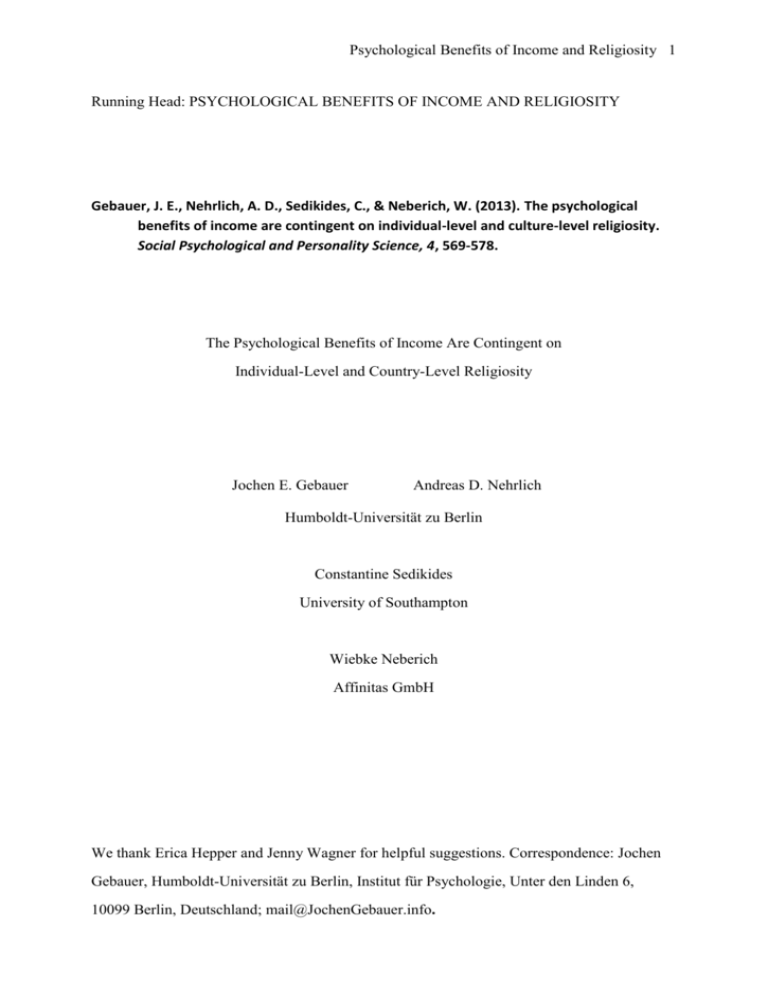
Psychological Benefits of Income and Religiosity 1
Running Head: PSYCHOLOGICAL BENEFITS OF INCOME AND RELIGIOSITY
Gebauer, J. E., Nehrlich, A. D., Sedikides, C., & Neberich, W. (2013). The psychological
benefits of income are contingent on individual-level and culture-level religiosity.
Social Psychological and Personality Science, 4, 569-578.
The Psychological Benefits of Income Are Contingent on
Individual-Level and Country-Level Religiosity
Jochen E. Gebauer
Andreas D. Nehrlich
Humboldt-Universität zu Berlin
Constantine Sedikides
University of Southampton
Wiebke Neberich
Affinitas GmbH
We thank Erica Hepper and Jenny Wagner for helpful suggestions. Correspondence: Jochen
Gebauer, Humboldt-Universität zu Berlin, Institut für Psychologie, Unter den Linden 6,
10099 Berlin, Deutschland; mail@JochenGebauer.info.
Psychological Benefits of Income and Religiosity 2
Abstract
Higher income is related to better psychological adjustment. We propose that religiosity
attenuates this relation. First, in comforting the poor, religious teachings deemphasize the
importance of money, which would buffer low income's psychological harms (religiosity as
poverty buffer account). Second, religious teachings convey anti-wealth norms, which would
reduce income's psychological benefits (religiosity as anti-wealth norms account). A study
involving 187,957 respondents from 11 religiously diverse cultures showed that individuallevel, as well as culture-level, religiosity weakens the relation between personal income and
psychological adjustment in accordance with the religiosity as anti-wealth norms account.
Performance self-esteem mediated this relation. Religiosity's moderating effects were so
pervasive that religious individuals in religious cultures reported better psychological
adjustment when their income was low than high.
Keywords: religiosity, culture, income, self-esteem, psychological adjustment.
Psychological Benefits of Income and Religiosity 3
Higher personal income is related to better psychological adjustment. The size of this
relation is modest, but persistent (r=.14, Cummins, 2000; .09≤r≤.44, Diener, Ng, Harter, &
Arora, 2010; r=.13, Diener & Oishi, 2000; r=.12, Diener, Sandvik, Seidlitz, & Diener, 1993;
r=.17, Haring, Stock, & Okun, 1984). In fact, the relation emerges robustly across many
demographic variables, including sex, age, and residence (urban-vs.-rural) (Diener et al.,
2010). For these reasons, this relation is considered meaningful and consequential (Kahneman
& Deaton, 2010; Nickerson, Schwarz, Diener, & Kahneman, 2003).
Religiosity as Poverty Buffer: Individual and Cultural Level
Nevertheless, there is reason to suppose that religiosity, at the individual level,
qualifies this relation. In comforting the poor, teachings of world religions deemphasize the
importance of money. The Judeo-Christian God is said to "save the souls of the needy"
(Psalm 72:13) and to "raiseth up the poor out of the dust, and lifteth the needy out of the
dunghill" (Psalm 113:7). Jesus purportedly stated: "Blessed be ye poor: for yours is the
kingdom of God" (Luke 6:20). Personal religiosity, then, may buffer the aversive
consequences of low income.
Independent of such individual-level effects of religiosity, culture-level religiosity may
also buffer low income’s aversive ramifications. With increasing culture-level religiosity,
devaluation of the poor may weaken and even vanish in religious cultures. The JudeoChristian tradition reinforces the belief that "he that hath mercy on the poor, happy is he"
(Proverbs 14:21) and "he that oppresseth the poor reprocheth his Maker: but he that honoureth
him mercy on the poor" (Proverbs 14:31). Similarly, God purportedly exclaimed "I the LORD
will hear them [the poor], I the God of Israel will not forsake them" (Isaiah 41:17), and most
members of religious cultures should seek to follow this example. Thus, both individual-level
and culture-level religiosity may independently attenuate the relation between higher income
and psychological adjustment, as religiosity will buffer low income’s psychological harms.
Religiosity as Anti-Wealth Norms: Individual and Cultural Level
Religiosity, at the individual level, may attenuate this relation for another reason. Antiwealth norms are central to world religions (Gebauer & Maio, 2012; Schwartz & Huismans,
1995). The Story of the Golden Calf (Exodus 32) provides a vivid illustration: “Then the
Psychological Benefits of Income and Religiosity 4
LORD said to Moses, ‘Go down, because your people, ... turn[ed] away from what I
commanded them and have made themselves an idol cast in the shape of a [golden] calf. ...
Now leave me alone so that my anger may burn against them and that I may destroy them’.”
Jesus allegedly advocated anti-wealth norm as well: “It is easier for a camel to go through the
eye of a needle than for someone who is rich to enter the kingdom of God” (Mark 10:25).
Hence, religious individuals are likely to endorse religious anti-wealth norms as personallyvalued goals (Schwartz & Huismans, 1995; Sedikides & Gebauer, 2010). For them, financial
goals should be little-valued, or even devalued, as sinful and guilt-arousing. Given that wealth
and income confer psychological benefits when financial goals are personally-valued
(Nickerson et al., 2003), individual-level religiosity may decrease the relation between higher
income and psychological adjustment, as religious anti-wealth norms will prohibit religious
individuals from reaping high income’s psychological benefits. The relevant literature is
scarce and suggestive. La Barbera and Gürhan (1997) compared 110 born-again Christians (a
religiously intense group) with 133 not born-again Christians. Whereas rich not born-again
Christians reported positive general affect, rich born-again Christians did not. This study,
though, failed to test whether differing degrees of religiosity are associated with reduced
psychological income benefits.
Independent of such individual-level effects, culture-level religiosity may also stand in
the way of benefiting psychologically from high income. In religious cultures, anti-wealth
norms are part of the cultural value system (Schwartz & Huismans, 1995; Sedikides &
Gebauer, 2010). People endorse cultural values as personally-valued goals (Greenberg,
Solomon, & Pyszczynski, 1997; Sedikides, Gaertner, & Toguchi, 2003). Together, people
from cultures high in anti-wealth norms (religious cultures) should adopt such norms as
personally-valued goals and do so even if they are not religious themselves given the norms’
transcendent or contagious influence (Bernard, Gebauer, & Maio, 2006). Hence, culture-level
religiosity will weaken the link between higher personal income and psychological
adjustment. We are unaware of relevant research.
In summary, we expect that the relation between income and psychological adjustment
will be modest, replicating past findings (Diener et al., 1993, 2010). However, this relation
Psychological Benefits of Income and Religiosity 5
will be moderated by religiosity: the relation will be lower among religious individuals.
Additionally, and independently, the relation will be lower in religious cultures. We test these
ideas in the backdrop of the religiosity as poverty buffer and the religiosity as anti-wealth
norms accounts.
The Role of Performance Self-Esteem
Heatherton and Polivy (1991) distinguished among three self-esteem domains:
performance, social, attractiveness. We examined whether the relation between income and
self-esteem is functionally comparable to that between income and psychological adjustment.
Specifically, we tested whether higher income is related to higher domain-specific self-esteem
and whether these relations are moderated by individual- and culture-level religiosity. We
hypothesized that only the results of performance self-esteem would parallel those of
psychological adjustment. Income falls into the achievement/performance domain (Schwartz,
1992) and, thus, higher income will evoke performance self-esteem. Moreover, the
maladaptive influence of low income on performance self-esteem may be ameliorated due to
religious teachings (earning little money does not render one's work less valuable; Parable of
the Laborers in the Vineyard; Matthew 20:1-16), and the beneficial effects of high income on
performance self-esteem may decrease due to religious teachings (earning much money does
not render one's work more valuable; Zacchaeus the Tax Collector; Luke 19:1-10). In
contrast, we see no reason why religiosity would moderate the (presumably low) relation
between income and social or attractiveness self-esteem.
Finally, we examined whether performance self-esteem mediates the relation between
income and psychological adjustment. Intuitively, performance self-esteem should function as
a mediator: high income will elicit pride in the achievement domain (performance selfesteem), which will boost psychological adjustment (Cummings, 2000). Indeed, high income
is an important value of most (non-religious) individuals and most (non-religious) cultures,
whereas living up to personal (Higgins, 1987) and cultural (Greenberg et al., 1997) goals is
most immediately linked to higher self-esteem (Gebauer, Wagner, Sedikides, & Neberich, in
press-c), which promotes psychological adjustment (Alicke & Sedikides, 2009).
Method
Psychological Benefits of Income and Religiosity 6
We analyzed data from 187,957 individuals (53% male; Mage=37.49 years, SD=12.22)
included in the eDarling dataset (Gebauer, Sedikides, & Neberich, 2012-a). Respondents were
from 11 European countries: Austria (N=17,109), France (N=18,105), Germany (N=19,318),
Italy (N=13,899), Poland (N=18,789), Russia (N=19,734), Spain (N=17,339), Sweden
(N=19,457), Switzerland (N=11,183), The Netherlands (N=13,552), and Turkey (N=19,472).
Respondents completed the measures confidentially while constructing profiles at the
eDarling online-dating site, which is designed for singles looking for long-term relationships
(Gebauer, Leary, & Neberich, in press-a). The sample is unrepresentative of national
populations on relationship status, but otherwise it is similar to them. For example, the
average median-age across the 11 countries is 40.54 years in nationally representative samples
and 37.18 years in the eDarling subsamples. Further, the average gender-ratio (number of men
per woman) across the 11 countries is .96 in nationally-representative samples and 1.22 in the
eDarling subsamples. Finally, the average annual income per-capita (standardized on each
country's purchasing power per-capita) across the 11 countries is 25,573 in nationally
representative samples and 28,111 in the eDarling subsamples ("The World Factbook," n.d.).
Thus, our sample is closer to representativeness on major demographic dimensions than are
student samples.
Personal Income
Respondents completed the item “How high is your gross income per year?”. They
had several response options (Kahneman & Deaton, 2010; Nickerson et al., 2003), which
varied between cultures due to different currencies.1 In Germany, for example, the response
options were: 1="0€," 2="less than 12,500€," 3="12,500—25,000€," 4="25,000—37,500€,"
5="37,500—50,000€," 6="50,000—75,000€," and 7="more than 75,000€." We set four
criteria to derive meaningful income scores that allow cross-cultural comparisons. First, we
excluded cases where respondents indicated zero income, because it cannot be interpreted
(Kahneman & Deaton, 2010).2 Second, we used the mean value of each income range
(31,250€ for "25,000—37,500€"). Given that there was no upper boundary for the highest
response option ("more than 75,000€"), we set the range for it equal to the range of the
preceding response option ("75,000—100,000€"). Third, we divided respondents’ income by
Psychological Benefits of Income and Religiosity 7
their country’s most recent purchasing power parity per-capita (Center for International
Comparisons, n.d.), so that scores reflect respondents’ personal purchasing power within their
country (Diener et al., 2010; Kahneman & Deaton, 2010). Finally, we log-transformed the
resultant scores (Diener et al., 2010; Kahneman & Deaton, 2010).
Individual-Level Religiosity
Respondents completed the single-item “My personal religious beliefs are important to
me” (1=not at all, 7=very much). Single-item religiosity measures are common and effective
(Schwartz & Huismans, 1995). Our measure was valid and reliable. In previous research, the
measure replicated well-established findings regarding religiosity and psychological
adjustment (Gebauer et al., 2012-a), and religiosity and personality (Gebauer, Paulhus, &
Neberich, in press-b). Also, in an independent validation study (N=347), the measure loaded
highly (.90) on a single factor together with validated measures of global religiosity (Gebauer
et al., 2012-a). One of these measures, the Global Religiosity Measure (Gebauer & Maio,
2012), includes the item "How strongly do you believe in God?" and thus is a proxy measure
for atheism-vs.-theism. This item correlated highly with our single-item measure in the
independent validation study, r(333)=.73, p<.001, suggesting that our single-item measure is
effective in differentiating between atheist and religious belief.
Culture-Level Religiosity
As in past research with this sample (Gebauer et al., in press-b, 2012-a), we
implemented three indices of culture-level religiosity. First, we averaged the individual-level
responses from our religiosity measure. Second, we used the average individual-level
responses from the Gallup World Poll (Diener et al., 2011). Finally, we used Zuckerman's
(2007) inverse portion of “non-believers in God.” Result patterns were identical and hence we
limit our reported findings to the first index.
Psychological Adjustment
We averaged the 10 items of the Trait Psychological Adjustment Scale (Gebauer et al.,
2012-a), which asks respondents “How well does each of the following generally describe
you?”, followed by 10 trait adjustment indicators: adaptable, calm, cheerful, content,
energetic, healthy, optimistic, positive, resilient, stable (1=not at all, 7=very much; α=.84;
Psychological Benefits of Income and Religiosity 8
mean item-total correlation: r=.54, range: .35≤r≤.65). In the independent validation study, this
scale loaded highly (.89) on a single factor together with established measures of life
satisfaction, positive affect, optimism, well-being, and vitality (Gebauer et al., 2012-a). Also,
this scale showed measurement invariance across cultures: unconstrained RMSEA=.029,
variance and factor-loadings constrained RMSEA=.028 (Cheung & Rensvold, 2002).
Self-Esteem
Respondents completed Gebauer, Leary, and Neberich’s (2012-b) 12-item trait
adaptation of the State Self-Esteem Scale (Heatherton & Polivy, 1991), including a 4-item
Performance Self-Esteem subscale ("I am proud of my educational background," "I catch on
to things quickly," "I can handle a lot of information," and "I am good at analyzing
problems;" α=.70), a 4-item Social Self-Esteem subscale ("How skilled do you perceive
yourself in..." "...social situations," "...making new friends," "...socializing," "It is easy for me
to engage in conversations with people I have just met;" α=.76), and a 4-item Appearance
Self-Esteem subscale ("I am satisfied with my physical appearance," "How well does the
following describe your physical appearance:..."...stylish," "... attractive," and "...sexy;"
α=.83) (1=not at all, 7=very much). The scale (including each subscale) manifested
measurement invariance across cultures: unconstraint RMSEA=.020, fully constraint
RMSEA=.024.
Results
Table 1 shows means, standard deviations, and mean zero-order correlations of all
study variables across cultures. For the main analyses, we used multi-level modeling (HLM
6.06; Raudenbush, Bryk, & Congdon, 2004), because respondents were nested in cultures. We
used group-mean centering of level 1 predictors and grand-mean centering of level 2
predictors, because our analyses involved cross-level interactions. Due to the large sample
size, we set the significance-level to .001.
Effects on Psychological Adjustment
In a first model (Figure 1), we predicted psychological adjustment with income,
individual-level religiosity, income×individual-level religiosity, income×culture-level
religiosity, and income×individual-level religiosity×culture-level religiosity. Table 2 displays
Psychological Benefits of Income and Religiosity 9
the results. A significant income main effect indicated that higher income predicted better
psychological adjustment. Importantly, a significant income×individual-level religiosity
interaction specified that this effect was reduced among religious individuals. Independently,
a significant income×culture-level religiosity cross-level interaction specified that the effect
of income on psychological adjustment was also reduced within religious cultures. The
income×individual-level religiosity×culture-level religiosity interaction did not reach
significance (at p<.001). The relation between higher income and psychological adjustment
was attenuated among religious individuals and within religious cultures.
Religiosity as a Poverty Buffer and Religiosity as Anti-Wealth Norms
We drew on two accounts why religiosity may diminish the relation between higher
income and psychological adjustment. First, higher religiosity buffers low income’s
detriments (religiosity as poverty buffer). Second, higher religiosity entails stronger antiwealth norms, resulting in decrease of high income’s benefits (religiosity as anti-wealth
norms). Complementing Figures 1 and 2, Figures 3a and 3b speak to these accounts, and we
proceed to interpret the relevant patterns. For ease of exposition, we refer to highreligiosity/high-income participants as "richer believers," to high-religiosity/low-income
participants as "poorer believers," to low-religiosity/high-income participants as "richer nonbelievers," and to low-religiosity/low-income participants as "poorer non-believers."
Figure 3a portrays the moderating effect of individual-level religiosity on the relation
between income and psychological adjustment within the lower-half countries in culture-level
religiosity (Sweden, Germany, France, The Netherlands, Switzerland; N=81,614). The
religiosity as poverty buffer account would explain this pattern as follows. Richer nonbelievers evinced better psychological adjustment than poorer non-believers, b=.22, SE=.01,
t(74,316)=24.53, p<.001 (simple comparison test; Aiken & West, 1991), likely because higher
income confers psychological benefits in the absence of religious anti-wealth norms (Diener
et al., 2010). Critically, poorer believers evinced better psychological adjustment than poorer
nonbelievers, b=.11, SE=.01, t(74,316)=9.65, p<.001, likely because religiosity buffers low
income's harms. The account, though, runs into subsequent trouble: richer believers were not
any better adjusted than richer non-believers, b=-.01, SE=.01, t(74,316)=-1.54, p=.12, albeit
Psychological Benefits of Income and Religiosity 10
religiosity confers modest psychological benefits in the relevant cultures (Diener et al., 2011;
Gebauer et al., 2012-a). DNA Thus, this account would need to evoke additional processes for
explicating why religiosity confers no psychological benefits among high income individuals.
In contrast, the religiosity as anti-wealth norms account can fully explain Figure 3a without
the need to summon additional processes. Richer non-believers evinced better psychological
adjustment than poorer non-believers, likely because higher income bestows psychological
benefits in the absence of religious anti-wealth norms. Poorer believers evinced better
psychological adjustment than poorer non-believers, likely because religiosity bestows
psychological benefits. Critically, richer believers did not evince better psychological
adjustment than richer non-believers, likely because religious individuals' anti-wealth norms
lessen the psychological benefits of income.
Figure 3b portrays the moderating effect of individual-level religiosity on the relation
between income and psychological adjustment within the upper-half countries in culture-level
religiosity (Italy, Spain, Russia, Poland, Turkey; N=88,920). The religiosity as poverty buffer
account would explain the pattern as follows. Poorer non-believers did not evince worse
psychological adjustment than richer non-believers, b=-.01, SE=.01, t(80,537)=-1.43, p=.15,
likely because culture-level religiosity buffers low income’s harms, and this should be the
case even among low religiosity individuals. Further, poorer believers evinced better
psychological adjustment than poorer non-believers, b=.24, SE=.01, t(80,537)=43.36, p<.001,
likely because religiosity confers psychological benefits particularly in religious cultures
(Diener et al., 2011; Gebauer et al., 2012-a). Critically, because richer and poorer nonbelievers were already equally well-adjusted, the account would anticipate that richer and
poorer believers also be equally well-adjusted. However, richer believers were worse-adjusted
than poorer ones, b=-.17, SE=.01, t(80,537)=-32.28, p<.001. This account, then, would need
to rely on additional assumptions or processes. In contrast, the religiosity as anti-wealth norms
account can fully explain Figure 3b. Richer non-believers did not manifest better
psychological adjustment than poorer-non-believers, likely because anti-wealth norms in
religious cultures reduce income's psychological benefits, and this may be the case even for
low religiosity individuals. Poorer believers manifested better psychological adjustment than
Psychological Benefits of Income and Religiosity 11
poorer non-believers, likely because religiosity confers psychological benefits particularly in
religious cultures. Critically, richer believers manifested worse psychological adjustment than
poorer ones, likely because of religious individuals' anti-wealth norms. Together, the law of
parsimony favors the religious anti-wealth norms account over the religiosity as poverty
buffer account.
Effects on Performance, Social, and Appearance Self-Esteem
We wondered whether the effects on psychological adjustment replicate with
performance (but not social or appearance) self-esteem as the criterion. In three consecutive
models, we predicted each self-esteem domain involving the same predictors as in the above
psychological adjustment model, while controlling for the other two self-esteem domains.
Results of the performance self-esteem model fully replicated those of the psychological
adjustment model (Table 3). The exception was a three-way interaction, which, however, did
not alter the overall results pattern (Figure 2). Performance self-esteem, then, was functionally
identical to psychological adjustment in its relation with income, individual-level religiosity,
culture-level religiosity, and their interactions. Hence, in line with theory and research,
performance self-esteem is a promising processing candidate for clarifying the effects of
income on psychological adjustment.
In contrast, results of the social and appearance self-esteem models did not replicate
those of the psychological adjustment model. First, higher income predicted somewhat lower
social self-esteem, and this small negative effect was driven by individuals from religious
cultures. Individual-level religiosity did not moderate income’s negative effect on social selfesteem. Thus, social self-esteem is an unsuitable process variable in our model (Baron &
Kenny, 1986). Second, higher income predicted somewhat higher appearance self-esteem, but
this effect was moderated by neither individual-level religiosity nor culture-level religiosity.
Appearance self-esteem is also an unsuitable process-variable in our model.3
Does Performance Self-Esteem Mediate the Income--Psychological Adjustment Link?
A precondition for mediation analyses is that the three relevant measures assess
distinct psychological constructs. Therefore, we tested for the distinctiveness of the constructs
underlying measures of performance self-esteem and psychological health. We began by
Psychological Benefits of Income and Religiosity 12
examining the correlation between performance self-esteem and psychological health. We
controlled for social and appearance self-esteem, because our planned mediation analyses also
controlled for these variables. Supporting the distinctiveness of performance self-esteem and
psychological adjustment, their relation was moderate across cultures, .25≤r≤.37, ps<.001
(mean r=.33). Next, we conducted a multi-group confirmatory factor analysis comparing
models with two correlated latent variables and a single latent variable. In the two-factor
model, the four performance self-esteem items served as indicators for one latent variable, and
the 10 psychological adjustment items served as indicators for the other latent variable. In the
single-factor model, all 14 items were indicators of the single latent variable. Comparison of
fit indices revealed that the two-factor model fit the data sufficiently well, CFI=.90,
RMSEA=.02, SRMR=.05, whereas the single-factor model did not fit the data well, CFI=.82,
RMSEA=.03, SRMR=.07. Evidently, the performance self-esteem and psychological
adjustment measures assess distinct constructs.
Subsequently, we examined whether performance self-esteem mediated the effect of
income on psychological adjustment while controlling for social and appearance self-esteem.
We ignored the role of religiosity, because our prior results showed that individual-level and
culture-level religiosity exerted parallel moderating effects on the relations between income
and psychological adjustment and between income and performance self-esteem.4 We
obtained a significant indirect path from income via performance self-esteem on
psychological adjustment, z=63.59, SE=.001, p<.001 (Sobel, 1982). Performance self-esteem
explained 100% of the variance regarding the effect of income on psychological adjustment
(Baron & Kenny, 1986). Finally, we tested the alternative mediation model in which
psychological adjustment mediates the effect of income on performance self-esteem. Due to
the large sample, we obtained a significant indirect path from income via psychological
adjustment on performance self-esteem, z=13.51, SE=.001, p<.001, but this path was weak:
psychological adjustment only explained 6% of the effect of income on performance selfesteem. Together, high income contributes to higher performance self-esteem, which in turn
promotes psychological adjustment.
Discussion
Psychological Benefits of Income and Religiosity 13
The benefits of income on psychological adjustment and performance self-esteem
were modest (Figures 1 and 2), replicating past research. Importantly, the benefits of income
were reduced among religious individuals. Independent of individual-level religiosity, these
benefits were also attenuated in religious cultures. Finally, performance (but not social or
appearance) self-esteem emerged as a process variable driving the effects of income on
psychological adjustment.
The findings highlight the explanatory potential of religiosity for the psychological
benefits of income. They illustrate that individual-level and culture-level religiosity can
independently influence income’s benefits on psychological adjustment and performance selfesteem. These independent effects were so pervasive, that religious people in religious
cultures reported higher psychological adjustment when their income was low than high
(Figure 3b).
Our findings help to address an enduring paradox pertaining to cross-cultural
differences in psychological benefits of income. Veenhoven (1991) hypothesized that income
is most beneficial when money is necessary to satisfy basic needs. He examined the relation
between income and happiness across 22 countries ('World Database of Happiness'), and
found stronger psychological benefits in countries with low (e.g., Dominican Republic,
Nigeria, India) than high (e.g., U.S.A., Australia, West Germany) GDPs per capita. To their
surprise, Diener et al. (2010) did not obtain the same pattern with the Gallup World Poll
sample, which is a representative sample of planet Earth. Despite the theoretical appeal of
Veenhoven's (1991) hypothesis, the 132 country-strong Gallup World Poll revealed stronger
psychological benefits of income in wealthier countries. Given that higher culture-level
religiosity is strongly related to lower culture-level wealth (Diener et al., 2011), Diener et al.'s
(2010) puzzling findings may be explained by our results that culture-level religiosity
decreases the psychological benefits of income.
We wondered about the causal direction between income and psychological
adjustment. As all other large-scale, cross-cultural datasets on income and psychological
adjustment (Diener et al., 2010; Kahneman & Deaton, 2010), our data are cross-sectional,
allowing no causal conclusions. However, smaller-scale studies have tested for causality and
Psychological Benefits of Income and Religiosity 14
found that higher income predicted better psychological adjustment, but not vice versa
(Diener & Oishi, 2000). Nonetheless, future research should consider longitudinal replication
of our results. It should also consider replication with non online-dating samples. Although
our sample was diverse in age, culture, and income, it comprised singles at an online-dating
platform. Yet, this limitation may entail advantages. The Gallup World Poll assesses
household income, but does not permit adjusting for household size (Diener et al., 2010). Our
results complement (and back) key findings from the Gallup World Poll by capitalizing on
personal income among singles.
We also questioned whether our results are generalizable to all religious
denominations. This hinges on whether anti-wealth norms are common to religious
denominations. Such norms are prominent in the five world religions (Buddhism, Christianity,
Hinduism, Islam, Judaism; Diener et al., 2011; Schwartz & Huismans, 1995). Given that
world religions shape a country's culture-level religiosity, our culture-level findings should
generalize to non-European countries. At the individual-level, however, there may be
boundaries to generalizability. Some denominations (or religious sectors within world
religions) may not advocate anti-wealth norms. If so, our individual-level results may not
replicate among individuals from such faiths.
The findings encourage speculation about real-life implications. Psychological
adjustment and self-esteem have motivational potential (Ryan & Deci, 2001; Sedikides &
Gregg, 2008). A stronger link between income and these motivational forces should nurture
more persistent strivings for financial success. Consequently, as long as religiosity fosters
anti-wealth norms, it may undermine financial strivings and success both at the individualand culture-level. This may be a mixed blessing: religiosity may curb ever-needed economic
growth but may also thwart individuals and cultures from making risky financial decisions.
Coda
Much research has focused on the psychological benefits of income. We examined the
moderating effects of individual- and culture-level religiosity. World religions embrace antiwealth norms in comforting the poor, and this should weaken the relation between higher
income and psychological adjustment among religious individuals and in religious cultures.
Psychological Benefits of Income and Religiosity 15
Results across 187,957 persons from 11 cultures supported these ideas. If religiosity continues
to decline in many cultures, the psychological benefits of income may keep on growing. This
trend would invite a fuller understanding of the psychological and cultural sources underlying
such benefits.
Psychological Benefits of Income and Religiosity 16
References
Aiken, L. S., & West, S. G. (1991). Multiple regression: Testing and interpreting
interactions. Newbury Park, CA: Sage.
Alicke, M. D., & Sedikides, C. (2009). Self-enhancement and self-protection: What they are
and what they do. European Review of Social Psychology, 20, 1-48.
The World Factbook. (n.d.). In Central Intelligence Agency. Retrieved from
https://www.cia.gov/library/publications/the-world-factbook/
Baron, R. M., & Kenny, D. A. (1986). The moderator–mediator variable distinction in social
psychological research: Conceptual, strategic, and statistical considerations. Journal of
Personality and Social Psychology, 51, 1173-1182.
Bernard, M., Gebauer, J. E., & Maio, G. R. (2006). Cultural estrangement: The role of
personal and societal value discrepancies. Personality and Social Psychology Bulletin,
32, 78-92.
Bloom, P. (2012). Religion, morality, evolution. Annual Review of Psychology, 63, 179-199.
Center for International Comparisons. (n.d.). Penn World Table 7.0. Retrieved from
http://pwt.econ.upenn.edu/php_site/pwt70/pwt70_form.php
Cheung, G. W., & Rensvold, R. B. (2002). Evaluating goodness-of-fit indexes for testing
measurement invariance. Structural Equation Modeling, 9, 233-255.
Cummins, R. A. (2000). Personal income and subjective well-being: A review. Journal of
Happiness Studies, 1, 133-158.
Diener, E., Ng, W., Harter, J., & Arora , R. (2010). Wealth and happiness across the world:
Material prosperity predicts life evaluation, whereas psychosocial prosperity predicts
positive feeling. Journal of Personality and Social Psychology, 99, 52-61.
Diener, E., & Oishi, S. (2000). Money and happiness: Income and subjective well-being
across nations. In E. Diener & E.M. Suh (Eds.), Subjective well-being across cultures
(pp. 185-219). Cambridge, MA: MIT Press.
Diener, E., Tay, L., & Myers, D. G. (2011). The religion paradox: If religion makes people
happy, why are so many dropping out? Journal of Personality and Social Psychology,
101, 1278-1290.
Psychological Benefits of Income and Religiosity 17
Diener, E., Sandvik, E., Seidlitz, L., & Diener, M. (1993). The relationship between income
and subjective well-being: Relative or absolute? Social Indicators Research, 28, 195223.
Galen, L. W. (2012). Does religious belief promote prosociality? A critical examination.
Psychological Bulletin, 138, 876-906.
Gebauer, J. E., Leary, M. R., & Neberich, W. (2012-b). Unfortunate first-names: Effects of
name-based relational devaluation and interpersonal neglect. Social Psychological and
Personality Science, 5, 590-596.
Gebauer, J. E., Leary, M. R., & Neberich, W. (in press-a). Big Two personality and Big Three
mate preferences: Similarity attracts, but country-level mate preferences crucially
matter. Personality and Social Psychology Bulletin.
Gebauer, J. E., & Maio, G. R. (2012). The need to belong can motivate belief in God. Journal
of Personality, 80, 465-501.
Gebauer, J. E., Paulhus, D. L., & Neberich, W. (in press-b). Big Two personality and
religiosity across cultures: Communals as religious conformists and agentics as
religious contrarians. Social Psychological and Personality Science.
Gebauer, J. E., Sedikides, C., & Neberich, W. (2012-a). Religiosity, social self-esteem, and
psychological adjustment: On the cross-cultural specificity of the psychological
benefits of religiosity. Psychological Science, 23, 158-160.
Gebauer, J. E., Wagner, J., Sedikides, C., & Neberich, W. (in press-c). Agency-communion
and self-esteem relations are moderated by culture, religiosity, age, and sex: Evidence
for the "Self-Centrality Breeds Self-Enhancement" principle. Journal of Personality.
doi: 10.1111/j.1467-6494.2012.00807.x
Greenberg, J., Solomon, S., & Pyszczynski, T. (1997). Terror management theory of selfesteem and cultural worldviews: Empirical assessments and cultural refinements.
Advances in Experimental Social Psychology, 29, 61-139.
Haring, M. J., Stock, W. A., & Okun, M. A. (1984). A research synthesis of gender and social
class as correlates of subjective well-being. Human Relations, 37, 645-657.
Psychological Benefits of Income and Religiosity 18
Heatherton, T. F., & Polivy, J. (1991). Development and validation of a scale for measuring
state self-esteem. Journal of Personality and Social Psychology, 60, 895-910.
Kahneman, D., & Deaton, A. (2010). High income improves evaluation of life but not
emotional well-being. Proceedings of the National Academy of Sciences, 107, 1648916493.
Kirkpatrick, L. A., & Ellis, B. J. (2001). An evolutionary approach to self-esteem: Multiple
domains and multiple functions. In M. Clark & G. Fletcher (Eds.), The Blackwell
handbook of social psychology (Vol. 2, pp. 411-436). Oxford, UK: Basil Blackwell.
Koole, S. L., McCullough, M. E., Kuhl, J., & Roelofsma, P. H. M. P. (2010). Why religion’s
burdens are light: From religiosity to implicit self-regulation. Personality and Social
Psychology Review, 14, 95-107.
La Barbera, P. A., & Gürhan, Z. (1997). The role of materialism, religiosity, and
demographics in subjective well-being. Psychology & Marketing, 14, 71-97.
McCullough, M. E., & Willoughby, B. L. B. (2009). Religion, self-control, and selfregulation: Associations, explanations, and implications. Psychological Bulletin, 135,
69-93.
Nickerson, C., Schwarz, N., Diener, E., & Kahneman, D. (2003). Zeroing in on the dark side
of the American dream: A closer look at the negative consequences of the goal for
financial success. Psychological Science, 14, 531-536.
Norenzayan, A., & Shariff, A. F. (2008). The origin and evolution of religious prosociality.
Science, 322, 58 – 62.
Raudenbush, S. W., Bryk, T., & Congdon, R. (2004). HLM for Windows (Version 6.06)
[Computer software]. Lincolnwood, IL: Scientific Software International.
Saroglou, V. (in press). Religion, personality, and social behavior. New York, NY:
Psychology Press.
Schwartz, S. H. (1992). Universals in the content and structure of values: Theoretical
advances and empirical tests in 20 countries. Advances in Experimental Social
Psychology, 25, 1-65.
Psychological Benefits of Income and Religiosity 19
Schwartz, S. H., & Huismans, S. (1995). Value priorities and religiosity in four Western
religions. Social Psychology Quarterly, 58, 88-107.
Sedikides, C., Gaertner, L., & Toguchi, Y. (2003). Pancultural self-enhancement. Journal of
Personality and Social Psychology, 84, 60-70.
Sedikides, C., & Gebauer, J. E. (2010). Religiosity as self-enhancement: A meta-analysis of
the relation between socially desirable responding and religiosity. Personality and
Social Psychology Review, 14, 17-36.
Sedikides, C., & Gregg, A. P. (2008). Self-enhancement: Food for thought. Perspectives on
Psychological Science, 3, 102-116.
Sobel, M. E. (1982). Asymptotic intervals for indirect effects in structural equations models.
In S. Leinhart (Ed.), Sociological methodology (pp. 290-312). San Francisco, CA:
Jossey-Bass.
Veenhoven, R. (1991). Is happiness relative? Social Indicators Research, 24, 1-34.
Zuckerman, P. (2007). Atheism: Contemporary numbers and patterns. In M. Martin (Ed.), The
Cambridge companion to atheism (pp. 47-65). Cambridge, England: Cambridge
University Press.
Psychological Benefits of Income and Religiosity 20
correlation (r) between income and
psychological adjustment
Figure 1. Zero-order correlation between income and psychological adjustment within each culture (AT=Austria, CH=Switzerland, ES=Spain,
FR=France, DE=Germany, IT=Italy, NL=The Netherlands, PO=Poland, RU=Russia, SE=Sweden, TR=Turkey).
culture-level religiosity
Note. =income—adjustment relation among high religiosity individuals within a given culture, including their best fitting regression line over all
cultures (
); =income—adjustment relation among low religiosity individuals within a given culture, including their best fitting regression
line over all cultures (
). High religiosity individuals were defined as individuals who on average scored 1SD (tolerance: ±0.25SD) above the
mean of their country's religiosity, low religiosity individuals were defined as individuals who on average scored 1SD (tolerance: ±0.25SD) below
the mean of their country's religiosity.
Psychological Benefits of Income and Religiosity 21
partial correlation (r) between income and
performance self-esteem
Figure 2. Partial correlation between income and performance self-esteem within each culture (social and appearance self-esteem controlled;
AT=Austria, CH=Switzerland, ES=Spain, FR=France, DE=Germany, IT=Italy, NL=The Netherlands, PO=Poland, RU=Russia, SE=Sweden,
TR=Turkey).
culture-level religiosity
Note. =income—performance self-esteem relation among high religiosity individuals within a given culture, including their best fitting regression
line over all cultures (
); =income—performance self-esteem relation among low religiosity individuals within a given culture, including
their best fitting regression line over all cultures (
). High religiosity individuals were defined as individuals who on average scored 1SD
(tolerance: ±0.25SD) above the mean of their country's religiosity, low religiosity individuals were defined as individuals who on average scored
1SD (tolerance: ±0.25SD) below the mean of their country's religiosity.
Psychological Benefits of Income and Religiosity 22
Figure 3a. The moderating effect of individual-level religiosity on the
relation between income and psychological adjustment within the
lower-half countries in culture-level religiosity.
Figure 3b. The moderating effect of individual-level religiosity on the
relation between income and psychological adjustment within the
upper-half countries in culture-level religiosity.
Psychological Benefits of Income and Religiosity 23
Table 1. Mean zero-order correlations (including their ranges across cultures) between all study variables, means, and standard deviations.
personal
income
individual-level
religiosity
individual-level
religiosity
psychological
adjustment
performance
self-esteem
social
self-esteem
appearance
self-esteem
-.06
-.14(TR)—.01(DE)
psychological
adjustment
performance
self-esteem
social
self-esteem
appearance
self-esteem
M
SD
.10
.09
.01(EE) —.17(SE)
-.01(SE)—.23(TR)
.21
.07
.53
.15(SE)—.25(NL)
.13(RU)—.02(CH)
.52(DE)—.55(PO)
.08
.10
.54
.46
.05(DE)—.13(IT)
.03(SE)—.15(RU)
.49(FR)—.62(RU)
.37(FR)—.50(TR)
.12
.10
.41
.41
.41
.07(RU)—.16(IT)
4.24
.49
.05(CH)—.17(FR)
3.40
2.03
.37(SE)—.46(RU)
5.41
.88
.37(CH)—.49(PO)
5.13
1.08
.36(IT)—.46(PO)
5.18
1.12
4.83
1.13
Note. AT=Austria, CH=Switzerland, ES=Spain, FR=France, DE=Germany, IT=Italy, NL=The Netherlands, PO=Poland, RU=Russia , SE=Sweden,
TR=Turkey.
Psychological Benefits of Income and Religiosity 24
Table 2. Psychological adjustment model (dfs=170,562)
main effect income
main effect individual-level religiosity
income×individual-level religiosity
income×culture-level religiosity
income×individual-level religiosity×culture-level religiosity
b
.13
.09
-.05
-.02
-.01
SE
.003
.002
.003
.004
.002
t
41.41
37.02
-16.40
-4.49
-2.00
p
<.001
<.001
<.001
<.001
ns
Psychological Benefits of Income and Religiosity 25
Table 3. Self-esteem models (dfs=170,560)
criterion: performance self-esteem
main effect income
main effect individual-level religiosity
income×individual-level religiosity
income×culture-level religiosity
income×individual-level religiosity×culture-level religiosity
criterion: social self-esteem
main effect income
main effect individual-level religiosity
income×individual -level religiosity
income×culture-level religiosity
income×individual-level religiosity×culture-level religiosity
criterion: appearance self-esteem
main effect income
main effect individual-level religiosity
income×individual-level religiosity
income×culture-level religiosity
income×individual-level religiosity×culture-level religiosity
b
.23
.04
-.04
-.05
.03
b
-.03
.04
.01
.03
-.02
b
.06
.08
-.01
.01
.02
SE
.003
.003
.003
.005
.003
SE
.004
.003
.003
.005
.003
SE
.004
.003
.003
.005
.003
t
70.12
16.68
-11.88
-9.94
11.08
t
-6.93
13.88
2.02
6.10
-6.52
t
16.97
27.26
-2.96
1.20
5.72
p
<.001
<.001
<.001
<.001
<.001
p
<.001
<.001
ns
<.001
<.001
p
<.001
<.001
ns
ns
<.001
Psychological Benefits of Income and Religiosity 26
NOTES
1
In Russia, there was the response-option “I do not want to respond.” 314 respondents (1.6%)
choose it and were excluded from further analyses.
2
Albeit respondents may not actively earn money, they have some income (e.g., student
stipends, financial support). After all, online-dating requires regular internet access, which is a
wealth indicator (Diener et al., 2010).
3
We re-ran the same model controlling for two level 2 covariates: the 2011 World Bank GINI
index (a measure of culture-level income inequality) and culture-level average income. We
added both covariates to the model in the same way as culture-level religiosity. Despite these
conservative controls, result patterns remained largely unchanged. We obtained a main effect
of income on psychological adjustment, b=.13, SE=.003, t(170,556)=40.37, p<.001, which
was qualified by an interaction with individual-level religiosity, b=-.04, SE=.003,
t(170,556)=-13.69, p<.001, and by a somewhat reduced interaction with culture-level
religiosity, b=-.02, SE=.01, t(170,556)=-2.31, p=.02. This main effect was neither qualified by
the GINI index, b=.0006, SE=.0009, t(170,556)=.69, p=.49, nor by culture-level average
income, b=-.01, SE=.02, t(170,556)=-.64, p=.52. Thus, the covariates cannot explain our
results. Further, considering these covariates' strong relation to culture-level religiosity
(Diener et al., 2011) and the relatively small number of cultures in our dataset (N=11), it is
remarkable that our cross-level interaction with culture-level religiosity remained largely
intact, p=.02. That is, although this cross-level interaction's p-value dropped below the set
significance-level (p=.001), change due to the conservative covariates was small; by
comparison, the cross-level interactions with the covariates fell far from significance, ps≥.48.
4
In line with this reasoning, controlling for individual-level and culture-level religiosity in the
mediation analyses did not change the results pattern.
